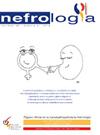Validación multicéntrica de la fórmula Kidney Failure Risk Equation (KFRE) en pacientes españoles con enfermedad renal crónica avanzada
IF 2
4区 医学
Q2 UROLOGY & NEPHROLOGY
引用次数: 0
Abstract
Introduction
Chronic kidney disease (CKD) is a prevalent condition that requires reliable tools to predict its progression to end-stage renal disease (ESRD). The KFRE equation, internationally validated, allows for estimating the risk of progression at 2 and 5 years. However, it has not been validated in the Spanish population. This study aims to evaluate the predictive capacity of the KFRE in a cohort of Spanish patients.
Methods
This is a multicenter, observational, and retrospective study conducted in patients with an estimated glomerular filtration rate (eGFR) < 30 ml/min who were followed in nephrology clinics between January 2016 and 2021. A total of 602 patients with clinical and demographic data were included. The predictive capacity of the KFRE, in its 4-variable and 8-variable versions, was evaluated using Cox regression analysis and ROC curves.
Results
Of the 602 patients included, 60% were male. Diabetes was the main etiology. Among the patients who started renal replacement therapy (RRT), 37% did so within two years, and 70% began with hemodialysis. Patients who initiated RRT (50.6%) were younger, had a lower eGFR, and exhibited higher baseline albuminuria. The 4-variable KFRE equation showed an AUC of 0.7639 (95% CI: 0.71-0.81) and demonstrated superior accuracy compared to the 8-variable model.
Conclusions
The KFRE equation, particularly in its 4-variable version, proves to be useful in predicting the progression to ESRD in the Spanish population. However, recalibration is necessary to improve its accuracy in this context.
西班牙晚期慢性肾病患者肾脏失败风险方程式(KFRE)的多中心验证
慢性肾脏疾病(CKD)是一种普遍的疾病,需要可靠的工具来预测其进展到终末期肾脏疾病(ESRD)。国际认可的KFRE方程可以估计2年和5年的进展风险。然而,它尚未在西班牙人群中得到验证。本研究旨在评估KFRE在西班牙患者队列中的预测能力。方法:这是一项多中心、观察性和回顾性研究,研究对象是肾小球滤过率(eGFR)和lt;2016年1月至2021年1月在肾脏病诊所随访30 ml/min。共纳入602例具有临床和人口统计学资料的患者。采用Cox回归分析和ROC曲线对4变量和8变量版本的KFRE的预测能力进行评估。结果602例患者中,男性占60%。糖尿病是主要病因。在开始肾脏替代治疗(RRT)的患者中,37%的患者在两年内进行了治疗,70%的患者开始进行血液透析。开始RRT的患者(50.6%)较年轻,eGFR较低,基线蛋白尿较高。4变量KFRE方程的AUC为0.7639 (95% CI: 0.71-0.81),与8变量模型相比,显示出更高的准确性。结论KFRE方程,特别是它的4变量版本,在预测西班牙人群的ESRD进展方面被证明是有用的。然而,在这种情况下,重新校准是必要的,以提高其准确性。
本文章由计算机程序翻译,如有差异,请以英文原文为准。
求助全文
约1分钟内获得全文
求助全文
来源期刊

Nefrologia
医学-泌尿学与肾脏学
CiteScore
3.40
自引率
7.70%
发文量
148
审稿时长
47 days
期刊介绍:
Nefrología is the official publication of the Spanish Society of Nephrology. The Journal publishes articles on basic or clinical research relating to nephrology, arterial hypertension, dialysis and kidney transplants. It is governed by the peer review system and all original papers are subject to internal assessment and external reviews. The journal accepts submissions of articles in English and in Spanish languages.
 求助内容:
求助内容: 应助结果提醒方式:
应助结果提醒方式:


